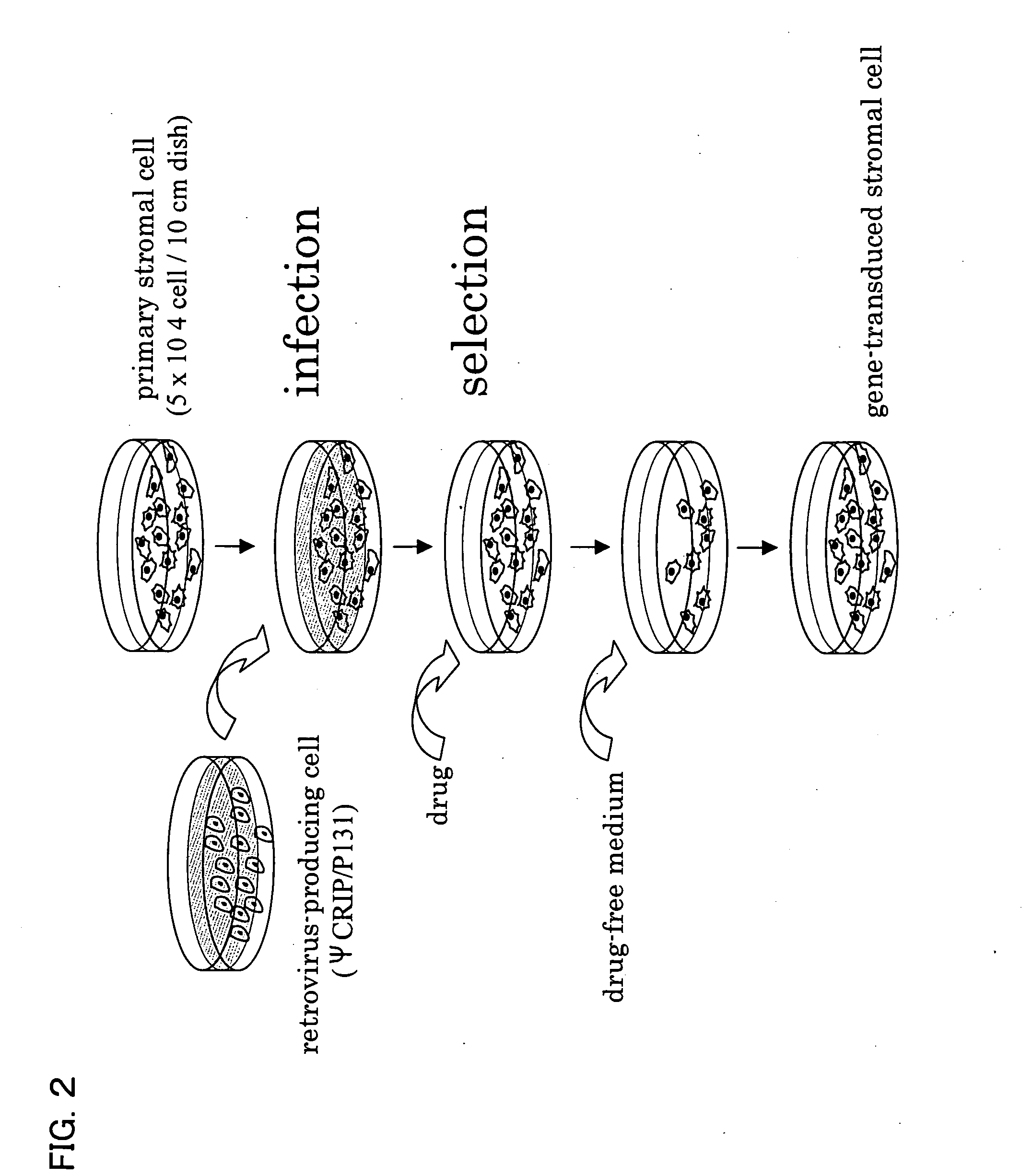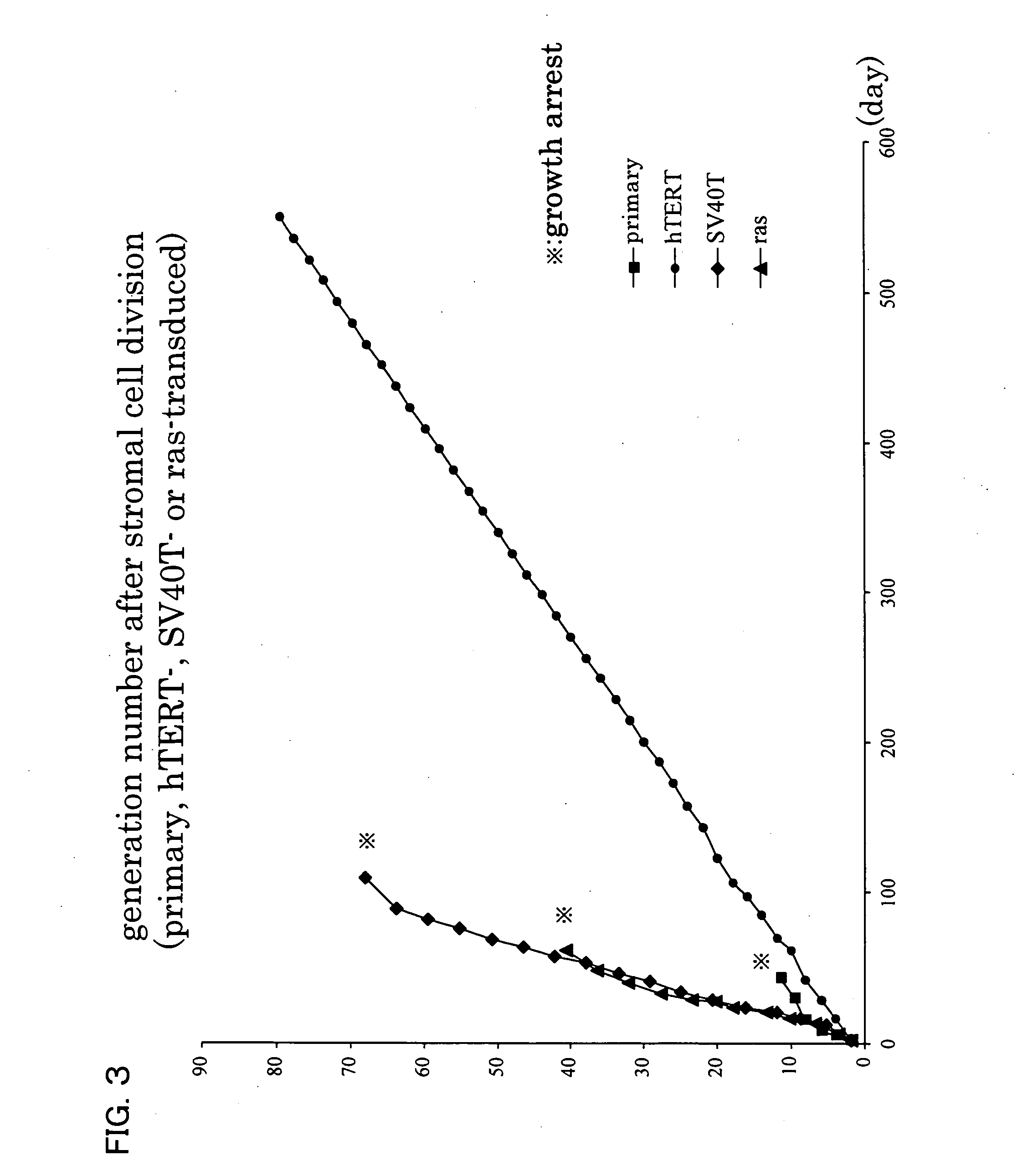Immortalized mesenchymal cells and utilization thereof
a mesenchymal cell and immortalization technology, applied in the field of expanding cells, can solve the problems of rare blood type blood donor shortage, and achieve the effect of enhancing the expansion of hematopoietic precursor cells and prolonging the lifespan
- Summary
- Abstract
- Description
- Claims
- Application Information
AI Technical Summary
Benefits of technology
Problems solved by technology
Method used
Image
Examples
example 1
Immortalization of Stromal Cells
[0088] 1. Collection of the primary stromal cells Mononuclear cells were isolated from 10 ml of bone marrow fluid that had been obtained from the ilium of a healthy adult man. After the mononuclear cells were cultured overnight, cells attached to a flask were used as stromal cells.
[0089] 2. A gene encoding the catalytically active subunit (hTERT) of human telomerase was used as a gene to be transduced into a stromal cell. The sequence of hTERT is described in, for example, Science 277, pp. 955-959. Further, an ras gene and an SV40T gene that are known as genes relating to cell canceration were also transduced into stromal cells.
[0090] 3. Vector to be used for transduction into stromal cells (FIG. 1) pBABE-hygro-hTERT (provided by Dr. Robert A Weinberg) was constructed by cloning an hTERT EcoR V-Sal I fragment, which had been obtained from pCI-Neo-hTERT-HA by PCR, into pBABE-hygro as described in Proc. Natl. Acad. Sci. USA vol 95, pp. 14723-14728. p...
example 2
Study of Telomerase Activity
[0117] To confirm the expression of hTERT gene transduced into a target cell and the generation of hTERT activity, telomerase activity was examined using a Telo Chaser of TOYOBO.
[0118] Telomerase activity was measured according to the protocols of Telo Chaser (TOYOBO) using Hela samples attached to the kit as a positive control. Telomerase was extracted respectively from stromal cells, hTERT gene-transduced stromal cells, and Hela cells that had been isolated by a method similar to that of Example 1. Using telomerase extracted from each type of cells, and telomerase heat-treated at 70° C. for 10 minutes after extraction from hTERT gene-transduced stromal cells, a reaction to add telomeric repeats to a substrate primer was performed, PCR was performed using reverse primers, and then polyacrylamide gel electrophoresis was performed for visualization. FIG. 8 shows the results. In FIG. 8, 1 indicates the molecular weight marker, 2 indicates the cytolytic so...
example 3
Characterization of Stromal Cell Line
(1) Study of Surface Antigen
[0121] Bone-marrow fluid was collected from the ilia of NK and KY of healthy individuals by bone marrow aspiration, and then mononuclear cells were separated by densimetric centrifugation. The obtained cells were cultured overnight, and then on the next day the cells attached to the flask were used as primary stromal cells.
[0122] Similar to Example 1, hTERT gene was transduced into a stromal cell using pBABE-hygro-hTERT.
[0123] Primary stromal cells and hTERT gene-transduced stromal cells were subjected to the expression analysis of cell surface antigens using FACS. The antibodies used herein were: CD45, CD9, CD105 (SH2), CD73 (SH3), CD166 (ALCAM) and CD157 (BST-1). Data collection and analysis were performed using Cell Quest. CD45 and CD9 were obtained from Immunotech, Marseille, France; CD166 (ALCAM) was obtained from Antigenix America, Huntington, USA; CD105 was obtained from Ancell, Bayport, USA; CD73 (SH-2) wa...
PUM
 Login to View More
Login to View More Abstract
Description
Claims
Application Information
 Login to View More
Login to View More - R&D
- Intellectual Property
- Life Sciences
- Materials
- Tech Scout
- Unparalleled Data Quality
- Higher Quality Content
- 60% Fewer Hallucinations
Browse by: Latest US Patents, China's latest patents, Technical Efficacy Thesaurus, Application Domain, Technology Topic, Popular Technical Reports.
© 2025 PatSnap. All rights reserved.Legal|Privacy policy|Modern Slavery Act Transparency Statement|Sitemap|About US| Contact US: help@patsnap.com



